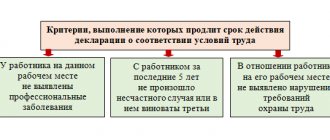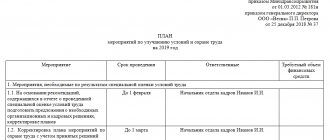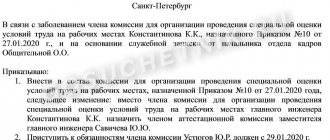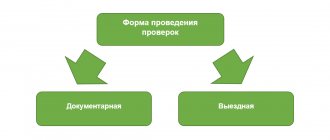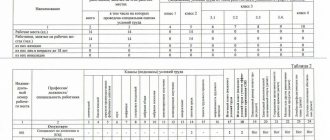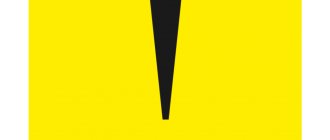2018 is, without exaggeration, a special and transitional year for all employers. This year, workplace certification is being replaced by a special assessment of working conditions (hereinafter abbreviated as SOUT). The fact is that in 2021, the term allotted to employers to comply with Federal Law No. 426-FZ “On Special Assessment of Working Conditions”, adopted in 2013, expires. In this article you will learn by whom and when the SOUT is carried out, the procedure for conducting it, and also who is exempt from such an event.
What is SOUT?
SOUT is a comprehensive analysis of all negative production factors and their impact on personnel, in order to determine the compliance of working conditions with current legislation and regulations.
Employees whose working conditions are found to be hazardous to health should receive monetary compensation, regular medical examinations and the possibility of early retirement. Experts note that according to the new rules, not only have the criteria for assessing the safety of places of work changed, but also the penalties for failure to comply with the requirements have been significantly tightened.
How is a special assessment of working conditions carried out?
Experts from an independent organization conducting a special assessment determine the presence of potentially harmful or dangerous production factors in the workplace:
- physical (noise, electromagnetic fields, ultrasound, radiation, vibration, temperature, illumination);
- biological (bacteria, spores, microorganisms);
- chemical (substances in the air of the work area and deposited on the skin of workers);
- sensory (nervous) tension of the labor process;
- functional physical activity on the body, etc.
If such factors are identified, then their actual values are measured, based on the results of which classes of working conditions (optimal, acceptable, harmful and dangerous) and their subclasses are established. The amount of additional insurance contributions to the Pension Fund will range from 0% for the optimal class and up to 8% for the dangerous one.
Based on the results of the special assessment, experts prepare a report, which must be approved by the employer’s commission. The report must be familiarized with the employees' signature within 30 days, and if the employer has an official website, then it must also be published on the website for free viewing. The expert organization submits the report to the labor inspectorate. If, as a result of the special assessment, no harmful or dangerous production factors were identified, then such workplaces are recognized as safe, and the employer also submits a declaration of compliance of working conditions with regulatory requirements within 30 days (regardless of the report submitted by the experts).
The declaration is submitted in the form and in the manner approved by Order of the Ministry of Labor dated February 7, 2014 No. 80n. It is valid for five years, but if during this period an accident occurs in a workplace recognized as safe or an employee is diagnosed with an occupational disease, then an unscheduled special assessment will need to be carried out.
By whom and when is SOUT carried out?
All material costs for conducting SOUT fall on the shoulders of the employer. A special commission is engaged in analyzing the state of working conditions, which includes:
- responsible for labor safety issues at the enterprise;
- an employee competent in matters of the enterprise’s activities, including production technology;
- trade union representative;
- a representative of an organization that has the right to conduct an examination (its presence is mandatory, and the expert organization must be accredited).
According to the law, employers who currently have certification according to the old model are required to conduct an assessment system in compliance with the new requirements by December 31, 2021. However, this does not apply to enterprises with hazardous working conditions; they must conduct an assessment immediately. Enterprises that have already carried out SOUT undergo the next inspection either scheduled, once every five years, or unscheduled. The prerequisites for an unscheduled inspection are:
- opening of new jobs;
- relocation of the enterprise to another address;
- change in production technology;
- industrial injuries, or deterioration in the health of employees in connection with their professional activities.
Six months are allotted to complete an unscheduled inspection.
Which places are subject to assessment?
The assessment is carried out for all workplaces without exception: stationary and non-stationary, office and industrial. The location of the places does not matter: places in own and rented premises are assessed, including places on the client’s premises.
Vacant jobs are exempt from assessment, as well as:
- places for remote workers;
- homeworkers;
- individuals who work under a contract;
- entrepreneurs working alone.
If the company has jobs with similar characteristics, you can not evaluate each one, but check 20% of the total number (but not less than 2).
Algorithm for conducting a special assessment
Step 1. Create an internal commission and draw up a schedule.
Step 2. Signing an agreement with an expert organization.
Step 3. Conducting the test and summing up the results.
Step 4. Drawing up an official report and assigning hazard classes.
Step 5. Familiarize employees with the results and send a declaration to the labor inspectorate.
If the employee does not agree with the assessment, a complaint is filed with the labor inspectorate. The decision is made in court.
The relationship between SOUT and taxes
- Income tax. Costs associated with conducting a special assessment can be included in the other costs column. When working on a simplified basis, valuation costs are not taken into account.
- Contributions from accidents. In form 4-FSS for the first quarter. 2019 should include the results of the assessment. They will allow you to get a discount when calculating tariffs for 2021.
- Contributions to the Pension Fund. The assessment is important in cases where the employee’s profession requires early retirement or he has to work in dangerous or life-threatening conditions.
Changes to SOUT in 2021
In 2021, several government orders and regulations regulating SOUT came into force, and official letters were issued. There were no significant changes, but there were many useful clarifications and minor improvements.
For example:
— prescribed the specifics of carrying out SOUT at the workplaces of workers in certain professions (for example, people destroying ammunition and drivers of urban ground transport);
— clarified that there is no need to obtain written consent from employees for the processing of personal data when organizing special operational management systems;
— changed the assessment of factors of severity and tension of the labor process;
— changed the Form of the summary statement of the results of the SOUT.
Summary
The assessment must be completed by December 31, 2021. A timely assessment is more beneficial for the employer than a possible suspension of activities, because failure to fulfill contracts can lead to serious negative consequences. To conduct an assessment assessment, it is important to choose the right organization in order to avoid the consequences of incorrect assessment. You should choose from the list indicated on the website of the Ministry of Labor.
Legislative acts regulating the conduct of SOUT:
- Federal Law dated December 28. 2013 426-FZ “On special assessment of working conditions.”
- Federal Law No. 421-FZ dated December 28, 2013 “On amendments to certain legislative acts of the Russian Federation in connection with the adoption of the Federal Law “On Special Assessment of Working Conditions”.”
- Decree of the Government of the Russian Federation dated April 14, 2014 No. 290 “On approval of the list of jobs in organizations carrying out certain types of activities in respect of which a special assessment of working conditions is carried out taking into account the specifics established by the authorized federal executive body.”
- Order of the Ministry of Labor of Russia dated January 24, 2014 No. 33n “On approval of the Methodology for conducting a special assessment of working conditions, the Classifier of harmful and (or) hazardous production factors, the report form for a special assessment of working conditions and instructions for filling it out.”
- Letter of the Pension Fund of the Russian Federation dated February 12, 2014 No. NP-30-26/1707 (amount of contributions to the Pension Fund).
- Order of the Ministry of Labor dated 02/07/2014 N 80n “On the form and procedure for submitting a declaration of compliance of working conditions with state regulatory requirements for labor protection, the procedure for creating and maintaining a register of declarations of compliance of working conditions with state regulatory requirements.”
- Order of the Ministry of Labor of Russia dated December 10, 2012 N 580n “On approval of the Rules for financial support of preventive measures to reduce industrial injuries and occupational diseases of workers and sanatorium and resort treatment of workers engaged in work with harmful and (or) hazardous production factors.”
- Federal Law of July 24, 2009 No. 212-FZ “On insurance contributions to the Pension Fund of the Russian Federation, the Social Insurance Fund of the Russian Federation, the Federal Compulsory Medical Insurance Fund” (Parts 1, 2, 2.1 of Article 58.3).
- Resolution of the USSR Cabinet of Ministers No. 10 of January 26, 1991 “On approval of Lists of production, work, professions, positions and indicators giving the right to preferential pension provision” (Lists No. 1 and 2).
- Labor Code of the Russian Federation, art. 92, 117 and 147 (guarantees and compensation for workers with harmful and dangerous conditions)
Procedure for carrying out SOUT
To carry out an assessment in accordance with all standards, a certain procedure must be followed. After concluding an agreement with an independent expert company, the composition of the commission and the schedule of activities are approved. The employer is obliged to provide all required documentation related to the organization of work and provide access to all premises. During the certification, a list of places of work to be assessed for safety, as well as existing positive and negative factors, is compiled. The result of the work done is a comprehensive final document containing all the necessary information:
- Documentation related to the organization of work provided by the employer.
- List of jobs to be assessed.
- Information about the expert company.
- Assessment of individual jobs.
- Summary documents for all workplaces.
- The result of the meeting of the certification commission.
- Action plan to improve working conditions.
- Conclusion.
Legislation governing special assessment of working conditions
In addition to Article 212 of the Labor Code of the Russian Federation, which specifies the obligation of employers to conduct a special assessment, the federal law of December 28, 2013 No. 426-FZ “On special assessment of working conditions” is in force. The assessment methodology itself was approved by Order of the Ministry of Labor dated January 24, 2014 No. 33n.
There are also many additional legal acts:
- intersectoral and sectoral rules on labor protection;
- state sanitary and epidemiological rules and regulations;
- occupational safety standards;
- standard instructions on labor protection for certain types of activities (for example, electricians, gas-electric welders, milling operators, etc.)
Responsibility for failure to conduct or violation of the conditions of a special assessment may be administrative under Art. 5.27.1 Code of Administrative Offenses of the Russian Federation (fine for individual entrepreneurs from 5 to 10 thousand rubles, for organizations from 60 to 80 thousand rubles) and criminal under Art. 143 of the Criminal Code of the Russian Federation (if this resulted in serious harm to health or death of the employee).
Who may not pass the certification?
SOUT is carried out by all organizations without exception, including individual entrepreneurs. Previously, only workplaces where potential sources of danger were used, that is, various mechanisms, special equipment, vehicles, etc., were certified. Now all jobs are subject to assessment, including office employees, except for those who work from home via remote access and those whose employers are individuals who have not been registered as individual entrepreneurs.
The cost of carrying out SOUT and factors influencing it
The price that needs to be paid for carrying out SOUT depends on the number of jobs, as well as on the nature of the enterprise’s activities. The cost of assessment for places where work is classified as safe without additional research is significantly lower than the price of a similar service for places where work is associated with hazardous factors that need to be comprehensively studied and analyzed. Depending on the number of factors that need to be taken into account, the price can range from 700 to 1,200 rubles. for one workplace. It should also be taken into account that there is no need to evaluate all similar places. Places located in the same room, adapted to perform the same functions, are considered similar. The total number of places subject to assessment cannot be less than two (except for enterprises with one workplace) and be less than 20 percent of the total number.

